

Editorial Board
Gov. Jeff Landry’s crusade for a tiger on the field serves as a statewide embarassment.



Gov. Jeff Landry’s crusade for a tiger on the field serves as a statewide embarassment.
LSU football suffers disappointing loss to Alabama.





BY JASON WILLIS @JasonWillis4
With the expansion of the College Football Playoff to 12 teams, the margin of error is greater than ever for teams to qualify in spite of shortcomings over the length of the season.
However, LSU has seemingly burnt all the way through that with only three games remaining.
Even with the unpredictability of the playoff selection system – being that it’s the first year of the expanded format – it seems almost certain that LSU was effectively eliminated from contention by its 42-13 loss to Alabama on Saturday.
“They’re disappointed, and I’m disappointed that we didn’t live up to the standard of LSU football,” head coach Brian Kelly said.
LSU fell behind Alabama early on as the offense settled twice for field goals, including once after being stopped at the goal line.
Costly turnovers by redshirt junior quarterback Garrett Nussmeier at both the end of the second half and the beginning of the first half brought positive LSU momentum to a screeching halt. Both times, the Crimson Tide cashed in for a touchdown.
LSU’s attempts to catch up offensively in the second half proved mostly unfruitful, as the Tigers didn’t score again after the two first half field goals until a touchdown with 17 seconds remaining.
Much of the suspense was gone from the game by the fourth quarter, as was much of the energy from a crowd that had begun the game with deafening vigor.
“As coaches, we’ve got to put our guys in a better position to succeed,” Kelly said. “That’s the challenge that I have. I own that.”
Two weeks after LSU struggled mightily defending the

quarterback run against Texas A&M, the Tigers showed little improvement on that front. Alabama quarterback Jalen Milroe, known for his electric ability on the ground, went off for 185 rushing yards and four rushing touchdowns. Alabama had its way with LSU in the trenches.
It was an example of a worrying team-wide regression for the Tigers: the defense had been on an impressive upward trajectory midway through the season with standout performances against Ole Miss and Arkansas.
However, LSU’s last two games have been perhaps its worst on that end of the ball, as the Tigers have allowed an average of 398 yards across those two games, including 276.5 on the ground.
The Tiger offense and specifi-

cally Nussmeier have also taken a step back since the early part of the season. In the four games since LSU’s September win over South Alabama, Nussmeier has thrown for 1,214 yards and six touchdowns to seven interceptions for a completion percentage of 54.8%.
Before that, he had 1,652 yards, 15 touchdowns to four interceptions and a 69.6% completion percentage across five games.
“He’s a first-year starter,” Kelly said. “He’s learning the ropes.” Kelly has defended Nussmeier in the past by pointing out the lack of help he’s gotten from his running game. LSU’s rushing attack did struggle again in this one. Aside from a 45-yard gallop by freshman running back Caden Durham, the Tigers mustered
only 78 rushing yards for an average of 3.7 yards.
The game was also characterized by LSU’s inability to get off the field on third down defensively. Alabama converted 10 of its 13 third downs, and LSU didn’t get its first third down stop until four minutes into the second quarter.
That was mostly due to Alabama’s excellent ability to keep its offense on schedule and create short third downs. Even on 3rd-and-medium or longer, though, Alabama had all the answers against the LSU defense.
LSU’s execution and preparation in all phases has left much to be desired over the past two losses. As a result, it’s now Alabama whose left playing to sustain playoff aspirations instead of the Tigers.

(225) 578-6090
Layout/Ad Design BEAU MARTINEZ
Layout/Ad Design CARLY LANGFORD
Layout/Ad
The Reveille is written, edited and produced solely by students of Louisiana State University. The Reveille is an independent entity of the Office of Student Media within the Manship School of Mass Communication. A single issue of The Reveille is free from multiple sites on campus and about 25 sites off campus. To obtain additional copies, please visit the Office of Student Media in B-39 Hodges Hall or email studentmedia@ lsu.edu. The Reveille is published biweekly during the
and summer semesters, except during
and final exams. The Reveille is funded through LSU students’ payments of the Student Media fee. The Reveille holds accuracy and objectivity at the highest priority and wants to reassure its readers the reporting and content of the paper meets these standards. This space is reserved to recognize and correct any mistakes that may have been printed in The Daily Reveille. If you would like something corrected or clarified, please contact the editor at (225) 578-4811 or email editor@lsu.edu.
BY CADE SAVOY
On Jan. 27, 2021, newlyelected President Joe Biden announced the Justice40 initiative. The initiative’s goals are ambitious, hoping to direct 40% of certain federal sustaibability benefits to disadvantaged communities.
But over three years removed from Biden’s inauguration, many marginalized communities across the country are still suffering from air pollution — and Baton Rouge is no exception. Human Rights Watch reported earlier this year that the air quality in the 85-mile stretch between Baton Rouge and New Orleans is so poor that it has earned the name “Cancer Alley.”
Aiming to fulfill the Justice40 initiative’s promise to deliver environmental justice to communities like those in Cancer Alley, the Inflation Reduction Act authorized roughly $5 billion in 45Q tax credits to be given to corporations that implement carbon capture technologies, commonly referred to as CCS, to reduce their environmental footprints.
“Climate change is a really important issue, and this is one of the few tools we have to address it,” said LSU environmental sciences Professor Brian Snyder. “Instead of emitting CO2 into the atmosphere, it is scrubbed from the exhaust, put into a pipeline, and injected into a deep well 5,000 to 10,000 feet below the surface of the Earth.”
But many believe that CCS will only exacerbate environmental problems in Cancer Alley.
Among the organizations that oppose carbon capture in Cancer Alley is RISE St. James — an environmental justice organization dedicated to fighting the industrial buildout in St. James Parish and beyond. In its “Factsheet on Carbon Capture,” RISE St. James condemns CCS as a “false solution” to air pollution that “does not move us forward towards a future powered by renewable energy.” The organization also points to newly documented scientific disputes over the effectiveness of carbon capture: “CCS proposes to inject CO2 underground and keep it there for thousands of years. However, in nearly every test case, the projects have failed. Huge projects that have promised nearly 100% CO2 cap -

BY JASON WILLIS @JasonWillis4
A live tiger returned to the sidelines of Tiger Stadium for the first time since 2015 after months of Gov. Jeff Landry publicly advocating to bring back the tradition.
As the LSU band lined up to march onto the field while play-
CAMPUS LIFE
ing the university’s fight song, the tiger was wheeled out in a cage that was attached to a purple and gold truck.
A bright light was shone on the tiger while an introductory video played over the stadium video boards. The tiger was on the field for less than 10 minutes before being wheeled back into
the interior of the stadium.
The tiger did not roar and there was no banging on its cage, as had been done when the tradition was first started.
The tiger was not LSU’s official mascot, Mike VII. The tiger’s legal name is Omar Bradley, and it was transported to LSU from Florida.
BY ALAYNA FORD @alayna_fordd
With an idea originating from tragedy, an LSU student has created a new organization to provide women on the university’s campus with safe and reliable transportation.
Pre-dental hygiene sophomore
Alisha Ortolano is the founder and current vice president of marketing for Girls Rides at LSU, an organization that was created in response to the death of LSU student Madison Brooks after leaving the popular bar area Tigerland in January 2023.
Ortolano took to Facebook following Brooks’ death to express her frustration, unintentionally starting the organization.
“Rape and sexual assault are more common than people think. I hate to say it but if she wouldn’t have passed away, none of this information would’ve come out, which makes me sick for all women in today’s world,” Ortolano posted.
“. . . If any of my Baton Rouge girls EVER need a ride home, no matter how well I know you or what time it is, I am always available to pick

you up or help find you a trusted ride home. Sending so much love to Madi’s family, sorority sisters and friends.”
Thus, the Girls Rides at LSU GroupMe was created.
The organization’s purpose is to help get women to and from where they need to be in Baton Rouge, as well as provide rides to the New Orleans Airport. The process is simple: when a student needs a ride, all they must do is message the group chat to ask for one. The organization is split into
BY
BATON ROUGE—A House tax committee voted Thursday to advance Gov. Jeff Landry’s proposal for a flat 3% personal income tax rate.
If approved by the full House and Senate, the plan would eliminate the current income tax brackets and move the state closer to Landry’s ultimate goal of eliminating the income tax.
Thursday’s vote by the House Ways and Means Committee marked the first step in passing what is seen as Landry’s flagship portion of the tax plan introduced during his Wednesday speech at a special session of the Legislature.
“This is an income tax cut for everyone in Louisiana,” said Rep. Julie Emerson, R-Carencro, who chairs the committee. “The overall goal is to stimulate the economy and broaden our tax base. We want to show the people we are lowering their personal income tax rates, just like other states where they are thriving.”
The committee passed the bill 15-3 vote, with Democratic Reps. Marcus Bryant of District 96, Mandie Landry of District 91 and Matthew Willard of District 97 in opposition.
“I voted against the flat tax because it is a regressive tax,” Rep. Landry said. “It rewards the rich and harms the poor.”
The committee also voted Thursday on another portion of Landry’s tax plan: eliminating the corporate franchise tax. The measure would remove the tax levied by the state on major corporations wanting to do business in Louisiana.
It passed 17-1, with Willard as the only dissenting member.
different sections to accommodate women in any situation that they need, and it is free for students to use.
This organization has grown to have over 1,600 members and counting, with at least one girl receiving a ride once a day.
“I feel like we are doing something really great on campus,” said the Vice President of Girls Rides at LSU and social work and psychology senior Lauren McKay. “I’ve met
These two bills will be considered by other House committees before they reach the House floor.
Jan Moller, the executive director of Invest in Louisiana, was disappointed by the committee’s decisions.
“An almost $2 billion tax cut was passed today,” he said, referring to the costs of both bills combined.
He said the benefits of the tax cuts will flow disproportionately to the wealthy and people living out of state. His fear is that the
BY CROSS HARRIS @thecrossharris
For LSU students who voted for President-elect Donald Trump, the results of the 2024 election came as a hopeful confirmation, despite any reservations about his character or regardless of the misgivings of others.
For Vice President Kamala Harris’ voters, the results were a sore, if unsurprising, turn of events spurred by a confused and ineffective Democratic Party.
Months of polling showed the presidential election would be a close call between Harris and Trump. The results of the election painted a very different picture.
Trump won all seven swing states, clinching the presidency by a comfortable margin and shifting voters from almost all demographics to the right. Harris was left in the dust.
“I thought it was going to be closer,” said political science senior Cody Middlebrooks, from Bunkie, Louisiana.
“I voted for Donald Trump, so I’m happy with it,” said finance senior Blaze Restivo from Denham Springs.
“I shouldn’t be surprised,” said
RIDES, from page 3
some of my best friends through this.”
Many women have gained connections and lifelong friends through interacting within the organization’s group chat. Most times this group of “girl’s girls” ask for help with things like job availability in the area or even the rehoming of kittens – a true story that occurred within the past few weeks, according to President of Girls Rides at LSU pre-vet sophomore Adriana Caldcleugh.
“It’s very empowering to kind of see girls take action. I can literally shoot out a text saying there are 12 kittens that need homes tonight and within an hour all of the girls in the chat will join together and those 12 kittens will have a home,” Caldcleugh said.
Not only are they affecting the lives of women on campus, but they’re also reaching out to a broader audience. After one of their TikToks received over 30,000 views, LSU professors reached out to the organization to include their information for future syllabi.
The organization has inspired other universities to start their own chapters, including Southern University, Northwestern State University and Southeastern Louisiana University, with the possibility of spreading to other schools outside of Louisiana.
“Everyone has been so sweet and so welcoming, and so seeing that so many people are proud and happy to be a part of what we are doing,” McKay said. “Like this is just the beginning and we are going to keep growing and keep getting farther and farther into the community, so I’m excited to see where it goes.”
psychology sophomore Stella Powell from North Louisiana. “I don’t know how to feel about it.”
Sitting in the E. J. Ourso College of Business, Middlebrooks pulled at the edges of his beard, as he considered the results. He described himself as a moderate who leaned to the right. And because he couldn’t square his political beliefs with either candidate this year, Middlebrooks said he decided not to vote.
He said he felt the right had gone too far in recent years. On issues like illegal immigration, he agreed there was a problem, “but I don’t believe going around and deporting millions of people is the right thing,” he said.
Middlebrooks thought the issue of abortion shouldn’t have been thrown to the states, but at this point, there was little those whom believe in choice could do to return to the pre-Dobbs era.
“With the economy being as bad as it is, it’s very hard to run off of issues that we can agree are important,” Middlebrooks said, “like transgender rights, abortion rights, when people are so worried about: How are they going to pay their bills? How are they going to make ends meet?”
The organization was facilitated entirely through GroupMe until Oct. 30, when it became an official campus organization. Under the advisement of Cassandra Chaney, a professor in the School of Social Work, the club can now participate in on-campus events and host some events of their own.
Besides giving rides to girls in need, the organization is also planning to give back to the community through future volunteer work with the Greater Baton Rouge Food Bank and possible givebacks with local fast food restaurant Small Sliders and jewelry brand Kendra Scott.
The organization has personally put Caldcleugh in a position to inspire young women. She was recently asked to speak at her high school to get senior girls to start their own Girls Rides chapters at their future universities.
“I’ll be speaking there to try to get some senior girls to start their own chapters at their respective universities,” Caldcleugh said. “We plan on going to speak to other universities and other organizations on campus.”
Girls Rides is having its first official club meeting on Nov. 12 at 6 p.m. Information regarding the club, membership and giveaways can be found on its Instagram at @ girlsrideslsu, or students can contact the girls through email at lsugirlsrides@gmail.com.
“We are literally just a group of ‘girls girls’ – so a group of women by women – so it’s great to see the impact it’s had so far,” Caldcleugh said. “Also, the amount of people willing to donate, reach out, to do givebacks and giveaways is overwhelming. We are super appreciative of that and it’s really great to see how the community supports a women’s safety group.”
Harris wasn’t a candidate that he could gladly support, he said. Maybe if there’d been a Democratic primary, or if Joe Biden had left the race sooner, that could have been different, but with a last-minute shift and the weight of Biden’s presidency dragging her down, Harris couldn’t swim.
Blaze Restivo said he voted for Trump because he believed he’d be better for business and immigration — and because Trump’s policies seemed to align with his Christian values.
“The Democrats are pro abortion. I think that that’s bad,” Restivo said. “Also the transgender stuff. I don’t think people should change their bodies. That’s how God created them.”
On the other hand, students like Stella Powell saw Trump’s win as a worrying indication of the nation’s attitude toward the LGBTQ+ community.
“It’s going to become dangerous for queer people,” Powell said. “It’s a little scary, especially because I have some LGBTQ friends.”
Construction management junior Evan Williams said he was surprised when he learned Trump, who he voted for, had won the election. Williams said he was hopeful
CANCER ALLEY, from page 3
ture rate have proved not to be able to meet these goals.”
There is also growing concern that CCS pipelines pose significant dangers to the communities in which they are constructed.
In the coming months, Blue Sky infrastructure will build a large carbon dioxide pipeline — dubbed the River Parish Sequestration Project — through Modeste, Belle Rose and Barton. As RISE St. James documents, there are 18 abandoned wells within three miles of the pipe -
TAX SESSION, from page 3
money given in the form of tax cuts to corporations will go shareholders elsewhere instead of staying in Louisiana to benefit education and healthcare.
“When you cut taxes to this magnitude,” Moller said, “you run the risk of having to make deep cuts to services citizens depend upon.”
The tax changes would cost the state $7.4 billion over the next five years. Landry aims to offset these reductions by broadening the sales tax base to tax more services such streaming services and luxury services such as lawn care as well as reducing special-interest tax breaks.
He says these changes will encourage businesses and families to stay in the state.
“If we do not act, studies show that one in four children will leave our state for better opportunities,” Landry told lawmakers Wednesday. “The time for piecemealing, stalling and kicking the can down the road is over.”
During his speech, Landry in-
but not excited about the next four years of his presidency.
“I’m not saying I completely like who he is, but for my beliefs it’s what happened,” Williams said, referencing his vote.
Psychology freshman Jai Cooper said she was unhappy with the results, especially given that the Republican Party had won a majority in the United States Senate and seemed to be closing in on one the House of Representatives as well.
Originally from Florida, Cooper said she didn’t vote because it had been too difficult to mail in an absentee ballot.
Cooper said she wasn’t surprised by the vice president’s loss. Biden’s presidency, she said, had “hurt” the Democratic Party.
Engineering freshman Claire Guidrose from New Orleans said she was surprised by the results, pointing to the echo chamber of social media.
“If you like one post about something on a website, it’ll be like, oh, this is your political affiliation and only show you that stuff.”
Guidrose said because of the posts she’d been seeing on social media, she thought Harris would win most of the swing states.
Guidrose also said she thought
line, and the project runs within two miles of St. Philip Baptist Church and Belle Rose Elementary School.
But Snyder maintained that carbon dioxide is sufficiently far from residential areas to minimize the risk of a leak. “Carbon dioxide is non-toxic, and it has to come in an extremely high concentration to harm human health,” he said. “If any CO2 were to be leaked, it would probably release a pretty low concentration — not enough to actually harm people.”
Still, to many environmental
troduced the other portions of his tax plan, which include eliminating the sales tax on prescription drugs and more than doubling the income tax deduction for seniors.
He also proposed a permanent pay raise for all teachers by tapping into a frozen $2 billion education fund.
The governor framed these reductions as essential investments in Louisiana’s future, suggesting that this relief for seniors and teachers would allow the state to retain talent and improve quality of life.
“Cutting our personal income tax by 30% will trumpet a new day in Louisiana,” he said. “We will effectively eliminate the income tax for the working poor, putting us on a path for eliminating the income tax once and for all,” Landry said.
much of the media discourse about Trump’s second presidency had been overdramatized.
“I don’t think it’s going to be as bad as people think it’s going to be,” she said.
Communication disorders freshman Joseph Mensman, from Baton Rouge, agreed.
“I don’t like him,” Mensman said of Trump. “But I’m not going to call him a fascist.”
Mensman said he voted for Harris because he believes she would do more to protect the environment.
“The biggest thing, for me, is climate change and making sure that we don’t mess up the whole planet by the time I’m old,” Mensman said, mentioning Trump’s withdrawal from the Paris Climate Accord in 2017.
Middlebrooks said he was already thinking about what would happen after Trump’s second term. Would a figure like J.D. Vance be able to take up the President-elect’s mantle? Or maybe the Democratic Party could be more successful without an unpopular incumbent?
“The fact that it went this way so much means it’s going to have to swing back the other way again,” Middlebrooks said.
activists along Louisiana’s coast, carbon capture does not represent meaningful environmental progress.
“There is currently a ‘gold rush’ to get projects designed and approved across the state,” RISE St. James observed in their CCS Factsheet. “This pipeline and injection process is being proposed in connection with the rise in new ammonia and hydrogen projects in the River Parishes, as well as existing industry wanting to dump its CO2 underground rather than change to using renewable energy.”
Landry says that if the Legislature does not accept his tax plan in full, then residents will be “stranded halfway across the river.” He says that every aspect of his plan must coincide with other parts of the proposal to achieve the kind of change that Louisianians need.
The state is heading for a fiscal cliff next year, thanks to the expiration of .45% of the state sales tax and a 2% business utilities tax in June 2025.
Moller believes that the easiest way to fix the fiscal cliff is to renew those taxes or replace them.
He is frustrated that the Legislature has called a special session right now to address the impending fiscal cliff. He said lawmakers are working on a tighter deadline than is necessary.
“A fiscal cliff is not a natural disaster,” Moller said. “The legislature created it. They can fix it.”
State legislators are privately expressing concern that they will not have enough time or information to make the changes that Landry wants without causing more problems than they solve.
Landry and Revenue Secretary Richard Nelson have been holding private meetings with various lawmakers and making public presentations to try to sell the plan.
Anna Puleo and Avery Sams contributed additional reporting.

ESPN College GameDay makes a reappearance for the first time since 2019 in the Quad on LSU Campus Nov. 9.
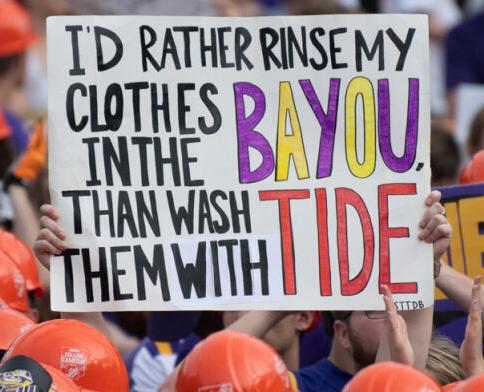
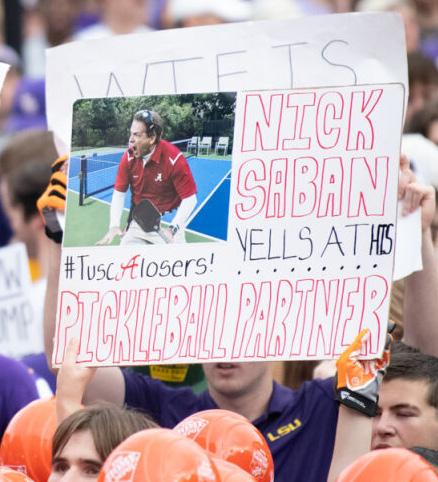

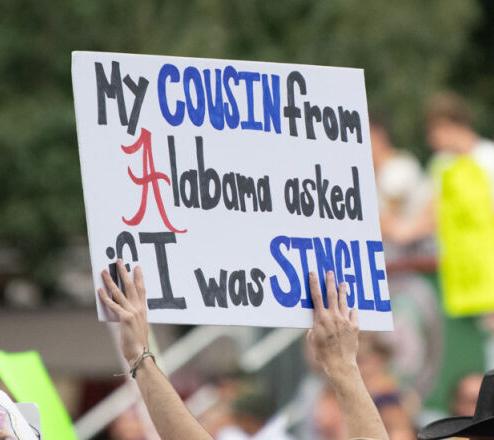
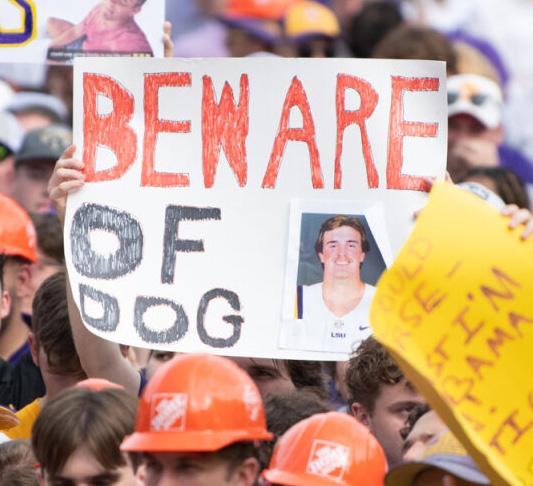
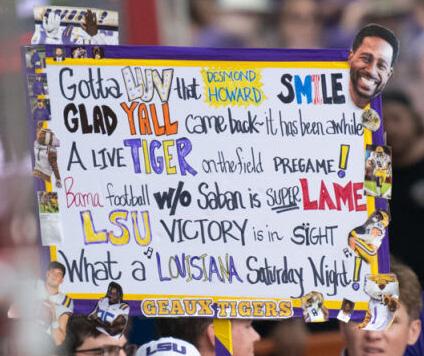
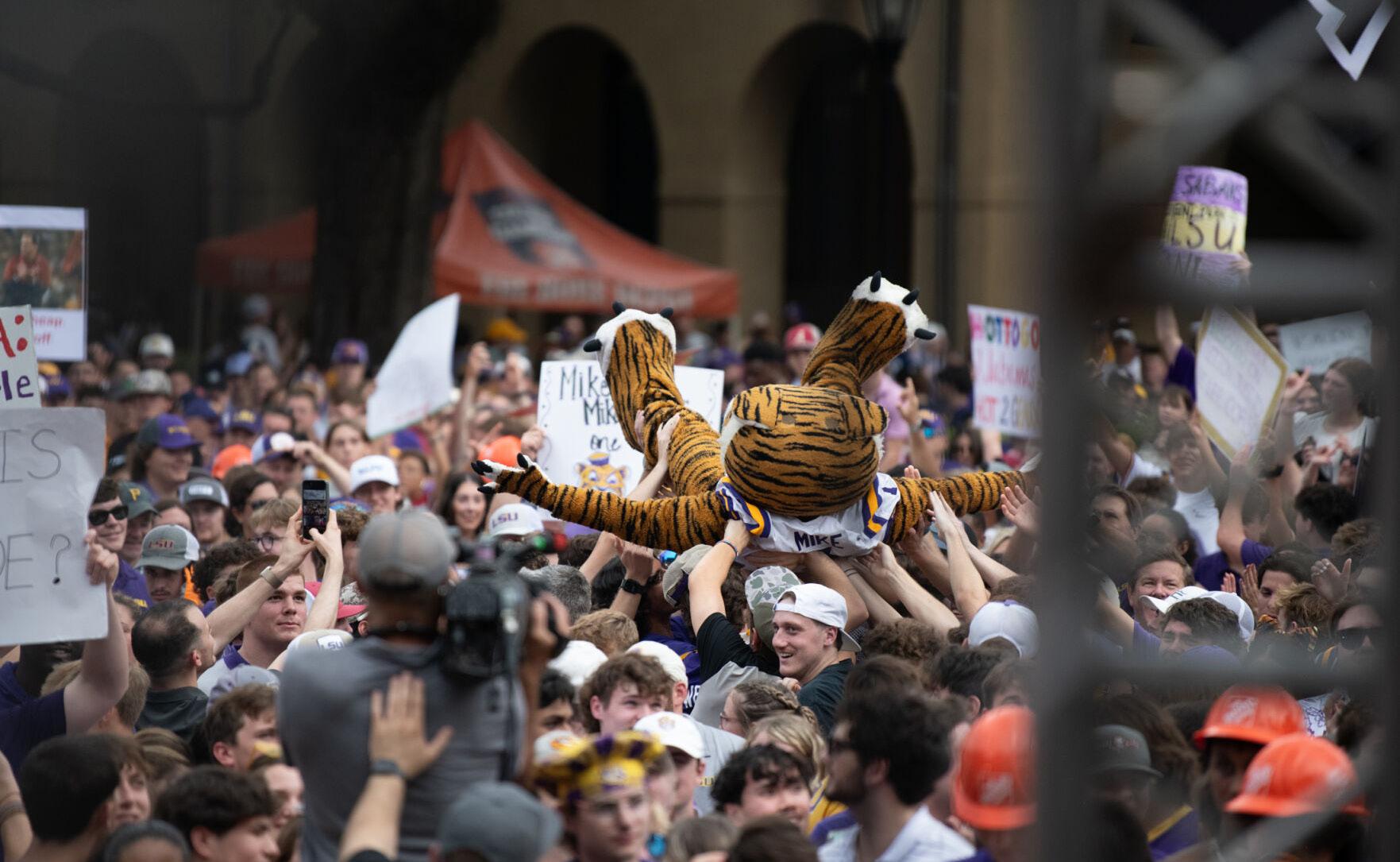

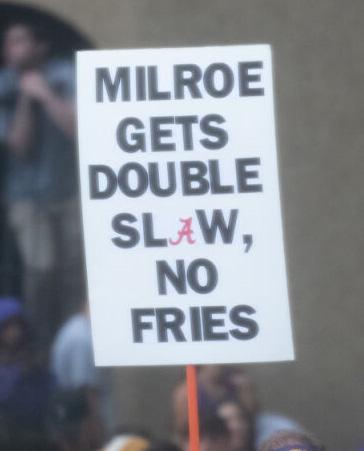


BY EMILY BRACHER @emily_bracher
The Big River Economic and Agricultural Development Alliance hosted its first annual Eat Local Week to celebrate the organization’s 28th anniversary and showcase local farmers.
BREADA is known for operating the Red Stick Farmers Market, a local food hotspot for Baton Rouge residents. Determining whether the food on the dinner table is local has been a major concern for many Louisianians, especially with the increase of processed foods hitting the grocery shelves.
Eat Local Week ran from Nov. 2 to Nov. 8 and partnered local farmers with local restaurants, with each restaurant serving an exclusive dish including ingredients provided by the farmers. It also included information on where everything came from.
Participating restaurants included Eliza Restaurant and Bar, Gail’s Fine Ice Cream, The Gregory, The Overpass Merchant and Rocca Pizzeria. BREADA’s executive Darlene Adams Rowland said the goal was for local farmers and chefs to make meaningful connections.
“We are grateful to our restaurants for showcasing the bounty of Louisiana agriculture during Eat Local Week,” Rowland said.
The 28th Red Stick Farmers Market Anniversary celebration took place on Nov. 2 in downtown Baton Rouge to kick off Eat Local Week. Guests had the opportunity to get satsuma mimosa’s from City Pork and enjoy food made by gourmet chef, Celeste Gill.
Allie Schleter, BREADA’s community engagement director, said Eat Local Week will encourage

the use of local products, rather than getting vegetables, meats and other foods from wholesale companies that ship them from thousands of miles away when producers are here in Louisiana. Through this initiative and the anniversary market, Schleter said they were spreading awareness of how eating local food benefits individual health, the environment and the economy.
“Being aware of where your food comes from is something that I think is so important,” Schleter said.
Schleter said Nov. 2 was one of the busiest days the market has ever had. Other than food demos and sales, there were activities for the little ones, like coloring a card to give to a farmer. One of Schleter’s coworkers went around the event in a corn costume to push the fact that BREADA is a nonprofit organization that relies on
grant funding and individual donations. BREADA also provided the vendors with brunch to show gratitude for everything they do.
“Without them, our markets wouldn’t exist,” Schleter said. “They are the ones who keep it going and they do a lot of hard work.”
BREADA was founded in November 1996, and the first Red Stick Farmers Market was hosted in the parking lot of the Government building on St. Louis St. Since then, BREADA has been doing more than hosting markets, but advocating for food policy changes, providing economic opportunities for farmers, offering nutrition incentives to encourage healthy eating and so much more.
The “BR” in BREADA stands for Big River, representing the farmers and vendors that come from 14 parishes across South Louisiana.
Through public markets, BREADA’s goal is to bring the community together to form connections that can be utilized in the future, such as these farmerrestaurant relationships. It brings in shoppers of all ages looking for an array of different items including seafood from Anna Marie Seafood, fresh hibiscus from Lena Farms or seasonal fruits and vegetables from Fekete Farms.
Roccas Pizzeria, located at 3897 Government St., got involved with Eat Local Week to help push its cause of using local ingredients. Front of house manager Andrew Burgess has been working at the restaurant on and off for the past four years. He has seen the chefs at Roccas prioritize locally sourced ingredients. He said it is sometimes a hard task with its frequent ordering basis, but by building a close relationship with farmers they have been including
Ramen can be an expensive treat. If you’re going to drop some change on a bowl of broth and noodles, it may as well be from Jinya Ramen Bar, located at 10000 Perkins Rowe.
Jinya Ramen Bar offers a variety of Japanese dishes from bao buns to mochi ice cream. Its ramen selection can be overwhelming with more than ten ramen flavors, all with different types of meat.


To ease the pressure of making a decision, I’ve made it for you: the spicy chicken ramen. The spicy chicken ramen is a combination of thin noodles, chicken broth, chicken chashu, spinach, spicy bean sprouts and topped with green onion. For this bowl, a choice of spice level is required. The hottest level is my personal preference, but if unsure of what your taste buds can handle, do not be afraid to start at the mild level.
Extra toppings can be added to the ramen bowl for a fee, but one to definitely add is a seasoned egg. The runny yolk mixed into the spicy broth creates a delicious, thick broth that pairs perfectly with the spice of the seasoning.
The spicy chicken ramen will run you $15.60, but customers have the choice to make it a combo with a side option. The side options include pork gyoza, a pork or chicken chashu bowl with salad, crispy chicken, tokyo curry rice or the impossible bowl salad.
as much local goods as they can.
“Rocca’s ability to maintain using local ingredients and things like that have been enticing to us all,” Burgess said.
After its inaugural year, Burgess hopes that other restaurants see the importance in Eat Local Week’s initiative by joining in on future events or by simply reaching out to vendors partnered with BREADA. Every chef has their own ideas of what they can do with these local products and Burgess said it would be nice to see how the cross utilization can go even further.
“Really just see how creative Baton Rouge can get with these amazing products that they offer at the farmer’s market,” Burgess said.
Some of the fruits and vegetables you find in your dish might be from Fekete Farms, one of BREADA’s recurring vendors. The farm is located in the heart of Hungarian Settlement, Louisiana with around 25 acres producing crops, everything done by hand labor. Frank Fekete has been farming since he was 16 years old and graduated from Louisiana State University with a vocational agriculture degree. Now, Fekete and his farm supports self-sustainable farms and local education programs.
“A lot of people now want to know where their food comes from,” Fekete said. “Local has better taste and it’s going to have more nutrients.”
Fekete Farms is not the only vendor present at the Red Stick Farmers market, dozens of other local producers attend. For more information on BREADA, their vendors and the Red Stick Farmers Market, you can visit their website.

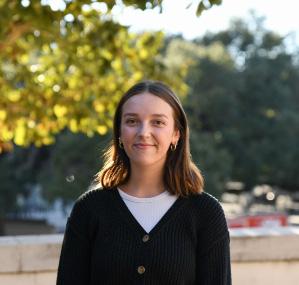



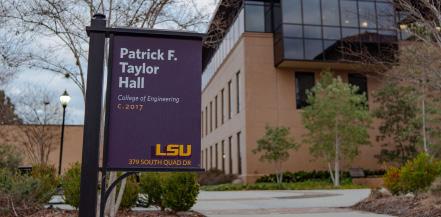
BY CARL DEXTER
@carldexter2005
Patrick F. Taylor, a prominent Louisiana philanthropist, allowed thousands of students in the state to achieve higher education through his creation of the Taylor Opportunity Program for Students (TOPS).
LSU honored Taylor’s contributions by renaming the former Center for Engineering and Business Administration (CEBA) to Patrick F. Taylor Hall (PFT) in 2007. The building’s rebrand honored Taylor’s dedication to creating educational opportunities for high-achieving and underprivileged students.
Commended for its innovative laboratories and modern architecture, Patrick F. Taylor Hall provides state-of-the-art facilities that encourage collaboration, research and handson learning. The PFT building reflects the values of its namesake, Patrick F. Taylor. Taylor, who devoted his life to the betterment of children, particularly through financial support in higher education.
One of the original TOPS recipients and a project manager with Entergy, Spencer Davis, recalls Taylor’s distinctive outfits. Others who knew Taylor described his fashion sense as a wealthy cartoon cowboy that came to life.
His fashion sense wasn’t the only extravagant aspect of Taylor’s life. He rode bulls, jumped out of over 500 planes and had a large collection of leopard and lion trophies from African safaris. As the owner of Taylor Energy, the only privately owned oil company in the Gulf of Mexico without investors, and one of Forbes’ top 400 richest people in 2003, Taylor lived a large and lavish lifestyle.
The first 183 students he sponsored saw Taylor as a role model who, like them, came from humble beginnings but achieved incredible success. During a motivational speech at a local school, Taylor pledged to pay for students’ college tuition if they maintained a B average: the promise that ultimately became the TOPS scholarship.
“The Taylor Plan is not a handout,” Taylor said in his speech. “It’s a reward for hard work.”
Taylor often made large donations the public never knew about, showing that he wasn’t in it for the good press, but to see the kids succeed. Once, he purchased all of the band uniforms for St. Augustine High School.
“He did it because that band is the best, and he knows how hard they work,” James Caillier, executive director of the Patrick F. Taylor Foundation said.
The scholarship has benefitted more than 200,000 students and his nationwide lobbying has led 12 other states to implement similar merit-based tuition grants. Anthony Reynolds, an LSU freshman and mechanical engineer major became one of the TOPS recipients this year.
“The TOPS scholarship has made my decision to attend college a no-brainer,” Reynolds said. “I am able to study and get my degree without sacrificing financial stability.”
Taylor’s legacy is not without controversy, and he often faced criticism for his oil business practices. Two months before his death, Hurricane Ivan toppled a Taylor Energy oil platform, which became known as the Taylor Energy Spill, making it the longest-running oil spill in U.S. history. The Taylor Foundation has since expanded its focus to include environmental initiatives, alongside its commitment to education since this event.
His wife, Phyllis Miller Taylor, took on the responsibility of continuing his legacy. She now oversees Taylor Energy and sustains its philanthropic support for students aspiring to higher education. Taylor’s legacy as an eccentric philanthropist who opened doors for thousands of Louisiana scholars remains impactful and worth celebrating.


BY LIZZIE FALCETTI @lizziefalcetti
There was a playmaker in Death Valley on Saturday Night. He was scrambling in the pocket, looking for lucky shots and extending plays for extra yards with his legs.
It was a look LSU fans were all too familiar with: a dual-threat quarterback who would tuck it and run when left optionless.
But this talent didn’t come from the LSU side. It was Alabama’s Jalen Milroe who created opportunities on offense all night long.
IHe was off to a hot start in the first quarter and didn’t look back in Alabama’s 42-13 win over the Tigers.
“His speed is really good,” LSU linebacker Greg Penn III said of Milroe. “You can’t really account for that at practice or in film until you’re really in the game. He’s just a great player...”
Only two minutes and 20 seconds into the game, Milroe rushed through the middle gap to free himself for 39 yards into the endzone.
This set the tone for Bama’s plan of attack. The Tide’s rushing game powered the offense, and Milroe led with 185 yards on the ground.
Alabama head coach Kalen Deboer told ESPN at halftime, “The
first touchdown really got him [Milroe] in a rhythm.”
To open the fourth quarter, Milroe proved he wasn’t finished. He ran the ball 72 yards up the sideline and went untouched into the endzone. By this point the Tide’s dominance was escalating, and the LSU fan attendance was declining, as many couldn’t continue watching this brutal Tiger takedown.
With College GameDay in town and famous analysts picking LSU to win, this outcome was not what many expected.
“I was excited about their preparation. They were ready to play, but I take ownership in not getting our guys in the right position tonight,” Kelly said. “We just did not make the best of the opportunities that we had.”
The day was full of festivities from thousands gathering in the quad Saturday morning to hundreds of more thousands screaming in Tiger Stadium, hoping LSU would pull out a comeback. However, the Tide kept crushing the Tigers.
“What we thought would be an exciting evening turned out to be a disappointing evening,” Kelly said.
LSU’s defense made strides to change the narrative in the second half but couldn’t make adjustments.

ERIN BARKER / The Reveille
Alabama quarterback Jalen Milroe (4) runs with the ball on Nov. 9 during LSU’s 42-13 loss to Alabama at Tiger Stadium.
Milroe rushed 19 yards for a touchdown early in the third quarter, extending the Tide’s lead to 22.
Along with effective rushing, Milroe had 109 passing yards on 18 attempts.
To cap off the Tide’s scoring, Alabama freshman Richard Young rushed the ball for eight yards into the endzone.
The Tide rotated through two
other running backs, Jam Miller and Justice Haynes, who combined for 61 rushing yards.
Coming off a bye, stopping the run was an issue the Tigers needed to address. In the Texas A&M game, LSU was up against quarterback Marcel Reed, who used his legs and became unstoppable against the Tigers defense. Going up against a quarterback with a similar threat,
LSU knew what had to be done.
The Tigers had two weeks to prepare for this. Milroe had four quarters to unravel that preparation.
“If you’re watching the game; you’re like, ‘What did these guys do for two weeks?’” Kelly said. “We have a scheme to stop the quarterback. We did not get it done.”
Alongside the defensive struggle against the run, LSU’s offense couldn’t get anything stirring. With only two field goals and one late touchdown to show for their drives, the Tigers lacked offensive production.
In the third quarter, when the Tigers came closest to a touchdown, quarterback Garrett Nussmeier threw an interception at the goal line.
Nussmeier had 239 passing yards and a 64% completion rate. He threw two interceptions.
In the most important game of the season for the Tigers, Brian Kelly and LSU couldn’t rise to the occasion in their own home. LSU’s SEC championship and College Football Playoff hopes are now gone with two conference losses.
The Tigers will aim to bounce back against Florida in Gainesville on Saturday Nov. 16.
BY ETHAN STENGER @itsethanstenger
Following the loss to Texas A&M, Kelly said his squad has prepared for the rushing quarterback. That has yet to ring true in the past two contests.
Aggies quarterback Marcel Reed had 62 yards and a hat trick of touchdowns off nine carries. Against Alabama, Milroe ran wild for a career-high 185 rushing yards and four touchdowns on twelve attempts. This comes a year after Milroe’s 155-yard, four-touchdown performance on the ground led the Tide past the Tigers.
“We’re not reinventing the wheel when it comes to defending the quarterback,” LSU head coach Brian Kelly said. “There’s only a couple ways to defend them.”
At this point, Kelly’s crew might be better off reinventing the wheel because whatever they have made is not working. When Kelly says that his defense has tightened up their scrambling quarterback squeeze, it feels kind of hard to believe him, at least until LSU puts together a competent performance against a rushing quarterback.
In two weeks, the Bayou Bengals host one of the best scramblers in the SEC, Vanderbilt quarterback Diego Pavia.
Alabama and LSU met in a top-15 showdown in Tiger Stadium at a crossroads: win out or go home. Through all the headlines, including a live tiger returning to Death Valley and the swirling rain, the Tigers decided on the latter: The Crimson Tide flooded the Bayou Bengals 42-13. “You’re living on borrowed time when you keep putting yourself in those tough positions, and tonight the dam broke when we kept putting ourselves in these tough positions,” LSU head coach Brian Kelly said. “The dam finally broke.” But what did we learn from all the tough positions and broken dams? Here are three takeaways from the loss.
It’s 3rd-and-11. The purple and gold trail by 15 and are set up at the Crimson Tide’s 49-yard line with 12 seconds left in the half. They need to try and get something here.
Quarterback Garrett Nussmeier swings it over to running back Caden Durham as he slips and falls in the wet grass of Death Valley, losing six yards. Halftime.
This was one of the many head-scratchers drawn up by LSU offensive coordinator Joe Sloan against Alabama. It felt as if Sloan needed more situational awareness throughout the game. When the Tigers needed only a couple yards, Sloan would opt to gun it; behind the sticks, Sloan would fall back on the run or short passes.
The Bayou Bengals got away from their run game early as Alabama controlled the clock throughout the entirety of the first half, doubling the amount of Nussmeier pass attempts to handoffs.
Sloan’s offense has looked electric in previous points this season. But against real competition like the Crimson Tide, some of Sloan’s faults finally came to light. It will be interesting to see the approach and identity that this team takes with them throughout their final three games.
With all the playmakers on the outside, expect the ball to be thrown around the yard in the future as Sloan looks to unlock Nussmeier to end the 2024 campaign.
As the clock hit zeros in Tiger Stadium on Saturday night, another clock began ticking.
How much time is left for Nussmeier and Kelly here in Baton Rouge?
Nussmeier has fallen back to up-in-the-air draft status as quickly as he ascended to potential first-round hopeful in April’s 2025 NFL Draft. His 11 interceptions are second in the SEC only to Georgia quarterback Carson Beck, as Nussmeier consistently throws up jump balls while trying to make plays that aren’t presented to him.
Kelly will end his third straight season at LSU without a playoff berth, but is his seat hot enough yet to warrant a firing?
If not, at some point, something has got to give in Baton Rouge. Kelly was brought to this program to win national championships, yet three years in, the Tigers have yet to sniff the postseason. Kelly’s crews are consistently good 10-win teams but never great, national championshipworthy teams.
If you want to be in that second category, you need to be able to beat Alabama in Death Valley, under the lights, with your season on the line. If you can’t do that, it’s time to find somebody who can.
With how Nussmeier has played in the back half of the season, his future is also up in the air. Where will Nussmeier end up? Only time will tell.
LSU’s final three games are at Florida and back home in Death Valley for Vanderbilt and Oklahoma. With neither Nussmeier nor Kelly’s seat in Baton Rouge reserved, the Tigers will look to soul-search throughout their final three games and find the answers they need in the offseason.
BY MARTIN SULLIVAN
@marty_sulli
Saturday morning MARKED the first time College GameDay made its way to Baton Rouge since 2019. Hundreds camped out the night before for a oneof-a-kind experience.
Prior to LSU’s showdown with Alabama, the College GameDay show TOOK place on the LSU quad from 8 a.m. to 11 a.m. Hundreds of students camped out to secure the best of seats in the viewing pit, with some hoping for a shot at the famed fan field goal.
Many of those interested in a chance to win over $100,000 with a kick through the uprights opted to set up as early as 5 p.m. the evening before. The line quickly advanced to and around the LSU library.
For others, it was just about being there.
“GameDay hasn’t been here in five years,” Cole Zachary said. “I’ve been waiting this long for this opportunity and I’m not gonna miss out.”
The traditions and love of

college football made camping out an easy decision for many.
“I figure Lee Corso is gonna retire this year, and I want to say I got to meet the guy,” sophomore Jacob Hirsch said. “He just makes Saturday more fun.”
Some made the call as soon as GameDay was announced to
be coming to LSU. For others, it was a “game time decision.”
“We knew we were gonna go, but staying the whole night was pretty impulsive,” Elliott Chandler said. “It’s just something you have to do.”
Many students had plans to camp out all night, tailgate Sat-

In response to being asked about the next day’s plans, multiple students said, “Win or lose, we must drink booze.”
The plans for potential sleep ranged from “hell no” to “a 45-minute power nap is definitely coming.”
“Only at LSU will you find people playing cup pong in line, people line dancing up there,” freshman Kaitlyn Mount said. “I feel like it’s so chill, people are just having a good time waiting in this line.”
Of course, no GameDay show would be complete without iconic signs.
urday, arrive early to the game and then go out to bars afterwards.
“I’m not gonna fall asleep. I’m gonna be up all night,” sophomore Brendan Ridder said. “Dude, I’m gonna do this once in my life. Why not? Just stay up.”
Here were some of our favorites from the early-appearing fans.
“Nick Saban pays for Grindr.”
“‘Bama Family Reunion” written next to an EA College Football stadium pulse graphic.
“’Bama gave Saban gray hair.”
“I just took a DNA test, turns out we’re 100% daddy” with the Alabama “A” in DNA.
BY MARTIN SULLIVAN @marty_sulli
LSU women’s basketball dominated Northwestern State Friday night 95-36, powered by a suffocating defensive performance.
The Tigers second game of the season demonstrated
a collective, aggressive style of play, amounting to 28 turnovers forced and allowed just 12 points within the arc. Strong performances from Flau’jae Johnson and Mikayla Williams carried the offense.
The tone was set early by Williams and Johnson imposing their will on both sides of
the ball. Despite pesky defense from LSU, Northwestern State kept up pace with four 3-pointers in the first quarter.
This didn’t continue: the Demons only made one more the rest of the game and were unable to produce down low. They finished 5-for-32 from three.
Despite a cold streak to start

the second, LSU dominated in the paint. Four blocks in the quarter set the tone underneath. Head coach Kim Mulkey also called a few quick hitters to get Aalyah Del Rosario involved early.
Offensively, the quarter was highlighted by Williams and Johnson playmaking off each other. This included draining threes within a minute of each other and Williams tipping a pass that was paid off by a Johnson and-one.
Out of the half, the Tigers started on an 8-0 run. A flurry of fouls and points in the paint from Aneesah Morrow put LSU up 46 to end the quarter.
In the fourth, nine players made exactly one field goal. The quarter was mainly played by the bench, who still allowed just eight points. Northwestern State did not score double digits in any quarter after the first.
Mulkey expressed frustration with the Demons’ last possession layup, pointing out they matched their score from last year’s game against LSU.
Still, the Tigers won emphatically.
The defense collectively played excellent in every capacity. Guards and forwards allowed nothing one-on-one, defensive help forced passes and a swarming defense forced consistent turnovers. Northwestern State finished with a field goal percentage of 19%.
Most responsible for this result was the high motor the entire roster played with. Guards pushed stubbornly through screens and forwards secured
their positioning throughout. Though not a close game, the Tiger’s hustle would make you think otherwise.
Johnson finished the game shooting 10-for-16 with 24 points, seven rebounds and two steals.
“It just looks like she’s just floating out there. Everything’s just effortless,” Mulkey said. “One of the things she did really good tonight, she fed the post early.”
LSU’s post offense wasn’t totally efficient but frequently benefitted from dynamic action opening up easy scores.
Mikaylah Williams finished 7-for-13, producing 16 points, four rebounds and four assists. It was a strong game from her defensively.
The speed of the offense was evident, frequently capitalizing off turnovers. They scored 32 on fast breaks and 41 off turnovers.
Kailyn Gilbert shined off the bench, especially in transition. She created six turnovers, scored 13 on 6-for-10 shooting, with seven rebounds and three assists.
“She was praised in that locker room after the game,” Mulkey said. “She has really put in the effort in practice, and it’s shown every game.”
Mulkey was frustrated with LSU’s turnovers, one of the few blemishes of the game. The team finished with 13, primarily off tight window and high lob passes.
LSU plays Charleston State next at home on Tuesday, Nov. 12 at 11 a.m.
Editorial Board: Gov. Landry strong-armed a tiger back into Tiger Stadium. After this shameful display, questions remain on what LSU will concede next.
BY EDITORIAL
Tiger Stadium has a capacity of over 100,000 people.
Not a single seat is set aside for a tiger – mascot or not.
That’s the way it should be, yet Saturday’s football matchup against Alabama saw a live tiger grace the inside of Death Valley for about the first time in a decade.
Mike the Tiger’s old trailer cage was paraded in the pregame show before a packed stadium. The lights fell to a deep purple before a single spotlight shone on the cage, with the bars casting severe shadows over the tiger.
Cheers and boos erupted from the crowd, most of them to some degree confused.
The tiger was not Mike VII. The university disallowed his display in 2017, saying it would, going forward, work to serve as strictly a sanctuary for future tigers.
“Responsible care for live exotic animals has evolved throughout the years, and LSU has evolved with it,” the university said in an official statement.
“LSU has decided that the tiger will not go into Tiger Stadium on home football game days. He will be out in his yard seven

days a week.”
It was instead Omar Bradley, a one-year-old tiger housed in Florida by an owner that’s been cited with animal abuse, selected as Saturday’s guest of honor.
Omar’s appearance comes after months of anticipation and a campaign spearheaded by none other than Louisiana’s chief executive, Gov. Jeff Landry.
Since at least September, he and a few other Republican congressmen have pushed for Mike the Tiger to be included in a home football game.
Landry had said before that he was hoping to honor the legacy of past Mike mascots, and on a Friday FOX News broadcast, he said there was hope to “get this tiger to roar a couple
of times.”
He continued, saying that perhaps for every roar, LSU’s football team would score a touchdown.
Omar must’ve remained silent. The game was a disappointing blowout loss.
The embarrassment extends far beyond football. It’s a vantage for the state and flagship university’s questionable handling of issues affecting all of Louisiana.
Landry’s crusade for a tiger on the field has drawn widespread bipartisan criticism for months. It spurred protests on campus and even an official condemnation from the People for the Ethical Treatment of Animals, also known as PETA, saying the display was “shameful” and “idiotic.”
Academic journals suggest that loud, earthquake-like atmospheres like Tiger Stadium hold negative ramifications on a tiger’s immune system, furthering their ability to contract diseases.
His campaign for a tiger on the field is simply out of touch with the interests of LSU’s community. It reeks of his wanting to appeal to the wide-reaching demographic of LSU fans despite never having attended the university.
At his very best, this was an awkward attempt at popularity.
At Landry’s worst, it’s an overreach of gubernatorial powers in which he strong-armed the university while holding its operating budget hostage and used taxpayer dollars to fund a dubiously constructed, wildly unpopular popularity stunt.
The energy Landry has devoted would be better spent on the special tax session he called, instead of on wrangling tigers.
And through it all, LSU has been strikingly silent. The university has issued no statements. It and the School of Veterinary Medicine have repeatedly not answered questions from the Reveille and other news outlets seeking clarification and logistical inquiry.
Has the university’s standard for responsible care of tigers changed? It seems contradictory that it’s been deemed unacceptable for mascot tigers to be paraded in the stadium but acceptable for non-mascot tigers to be.
Omar is not LSU’s mascot and should never have been used as a figurehead for Landry’s misguided nostalgia campaign. His appearance on the field is confusing, and the university’s seeming silence throughout Landry’s stunt makes it all the more bewildering.

ANDREW’S ANGLE
ANDREW SARHAN @sarhanandrew
It was 11:37 p.m. on Halloween, and it was raining heavily. I was on my way to drive a friend home. The rain didn’t seem to stop pouring. The high-beam headlights on my car didn’t do much to light the dimly lit road ahead of me. I got concerned, but I drove slowly.
My speed seemed to irritate a certain Ford F-250 driver, who
Colin Falcon Editor in Chief
Editor John Buzbee
tailgated me along Nicholson until I turned, in which he sped past me and honked his horn. Whatever, at least I was safe.
I don’t really blame the F-250 driver; I know I was going under the speed limit, and for good reason, too: I couldn’t see the road. Between the lights of the car tailgating me, the rain and the darkness outside, I was afraid of running into something or slipping off the road.
Of course, there’s an easy solution to this, and that is to install light posts along Nicholson Drive. LSU or the city, whoever is tasked with installing the street-
lights, can install them near the sidewalk that runs along Nicholson.
Not only would this improve visibility on Nicholson itself, but it would also increase the visibility on the sidewalk that runs alongside the street. This sidewalk passes Tigerland and extends to West Lee Drive, connecting campus to the developing Ben Hur area. Hypothetically, I could bike the entire route from Brightside Drive to campus without going into the road, making it a safer alternative and biking more ecologically friendly than driving.
This lighting would make it safer for students living off Nicholson and those who want to safely go to a bar without driving. Even though the data for 2023 is better than the years that passed, 221 people in Louisiana lost their lives due to drunk drivers. If the sidewalks were lit up throughout the route, students would be less likely to want to drive to and from a bar, especially if they’ll be intoxicated afterwards.
I am surprised and a bit disappointed that the city of Baton Rouge or LSU didn’t address the fact that there are no street lights over here. It seems like such
an obvious blind spot, which is very noticeable after LSU football games or any other event.
In summary, we must push for more lighting along Nicholson because it would be safer for drivers, pedestrians and cyclists. Installing lights isn’t as terribly expensive as other ventures, with each lamppost only costing around $3000. This way, we can shine a light on a brighter, safer future for the city of Baton Rouge.
Andrew Sarhan is an 18-yearold mass communication freshman from Baton Rouge, La.
The Reveille (USPS 145-800) is written, edited and produced solely by students of Louisiana State University. The Reveille is an independent entity of the Office of Student Media within the Manship School of Mass Communication. Signed opinions are those of the author and do not necessarily represent the views of the editor, The Reveille or the university. Letters submitted for publication should be sent via e-mail to editor@lsu.edu or delivered to B-39 Hodges Hall. They must be 400 words or less. Letters must provide a contact phone number for verification purposes, which will not be printed. The Reveille reserves the right to edit letters and guest columns for space consideration while preserving the original intent. The Reveille also reserves the right to reject any letter without notification of the author. Writers must include their full names and phone numbers. The Reveille’s editor in chief, hired every semester by the LSU Student Media Board, has final authority on all editorial decisions.
“Those who foolishly sought power by riding the back of the tiger ended up inside.” John F. Kennedy